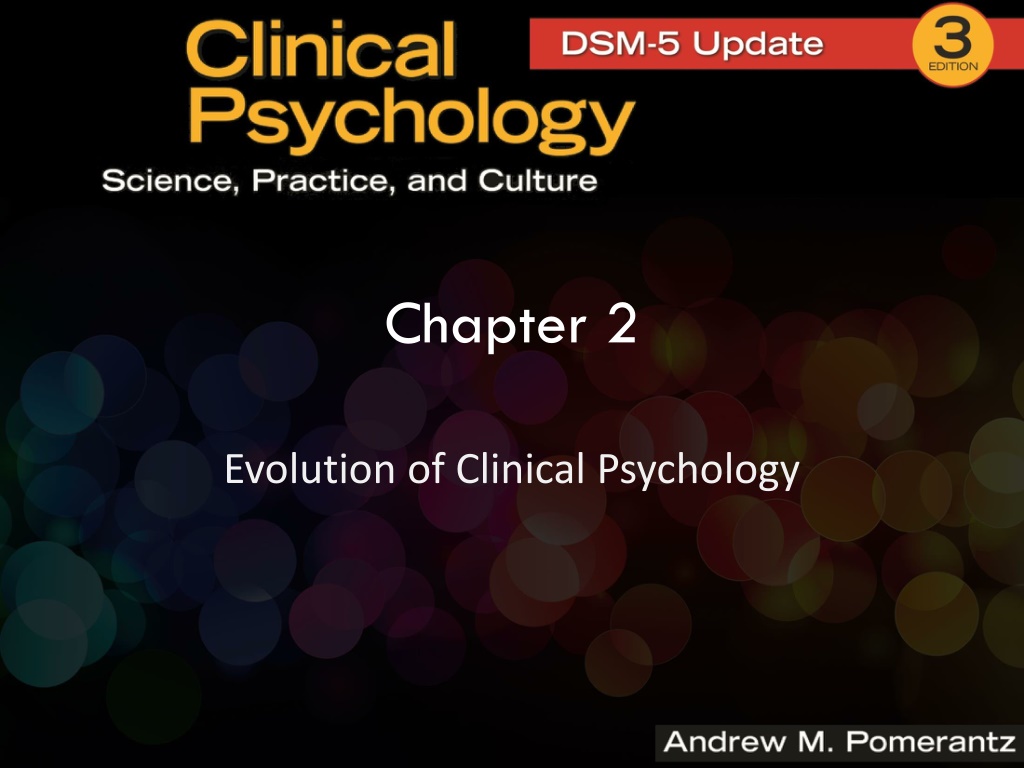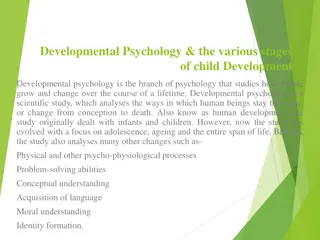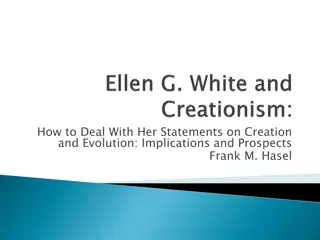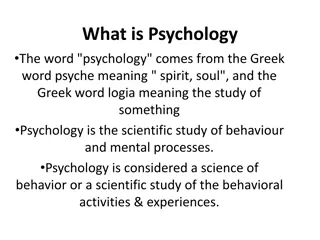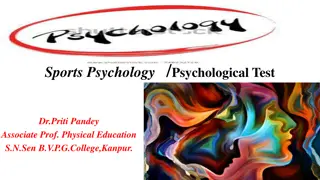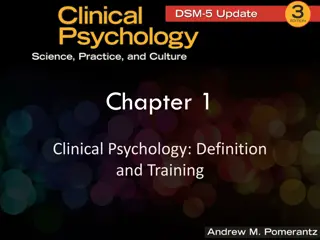Evolution of Clinical Psychology: Early Pioneers and the Creation of Clinical Practice
The evolution of clinical psychology is traced from the 1700s to the early 20th century, highlighting key figures such as William Tuke, Philippe Pinel, Eli Todd, and Dorothea Dix who advocated for humane treatment of the mentally ill. Lightner Witmer's establishment of the first psychological clinic in 1896 marked a pivotal moment in the field's transition from academic study to practical application.
Download Presentation

Please find below an Image/Link to download the presentation.
The content on the website is provided AS IS for your information and personal use only. It may not be sold, licensed, or shared on other websites without obtaining consent from the author. Download presentation by click this link. If you encounter any issues during the download, it is possible that the publisher has removed the file from their server.
E N D
Presentation Transcript
Chapter 2 Evolution of Clinical Psychology
Evolution of Clinical Psychology The emergence of clinical psychology around the turn of the 20thcentury was preceded by numerous important historical events These events set the stage for clinical psychology Some pioneers in the treatment of the mentally ill made important contributions in the 1700s and 1800s
Early Pioneers William Tuke 1732-1822 Lived in England Appalled by deplorable conditions in asylums where mentally ill lived Devoted much of his life to improving their treatment Raised funds to open the York Retreat, a model of humane treatment
Early Pioneers Phillippe Pinel 1745-1826 Lived in France Advocated for more humane and compassionate treatment of the mentally ill in France Also introduced ideas of a case history, treatment notes, and illness classification, indicating care about their well-being
Early Pioneers Eli Todd 1762-1832 A physician in Connecticut At the time, there were very few hospitals for the mentally ill Burden for their care fell on families Using Pinel s efforts as a model, he opened humane treatment centers in US
Early Pioneers Dorothea Dix 1802-1887 Worked in a prison in Boston, and observed that many inmates were mentally ill rather than criminals Traveled to various cities to persuade leaders to build facilities for humane treatment of mentally ill Resulted in over 30 state institutions in US and other countries
Lightner Witmer and the Creation of Clinical Psychology Lightner Witmer 1867-1956 Received doctorate in 1892 in Germany Psychology was essentially academic; no practice, just study In 1896, Witmer founded the first psychological clinic at the U. of Pennsylvania
Lightner Witmer and the Creation of Clinical Psychology By 1914, there were about 20 clinics in US By 1935, there were over 150 Witmer also founded the first scholarly clinical psychology journal, The Psychological Clinic, in 1907
Evolution of Assessment: Diagnostic Issues Diagnosis and categorization of mental illness has been central to clinical psychology from the start Emil Kraepelin (1855-1926) is considered a pioneer of diagnosis Coined some of the earliest terms to categorize mental illness
Evolution of Assessment: Diagnostic Issues Kraepelin s work set the stage for the Diagnostic and Statistical Manual (DSM), which continues to dominate diagnosis today Published by American Psychiatric Association, originally in 1952
Evolution of Assessment: Diagnostic Issues DSM 1952 DSM-II 1968 DSM-III 1980 DSM-III-R 1987 DSM-IV 1994 DSM-IV-TR 2000 DSM-5 2013
Growth of the DSM Disorders Pages 350 1000 991 900 886 300 297 292 800 265 250 700 600 200 567 182 500 494 150 400 300 106 100 200 50 134 130 100 0 0 DSM-I (1952) DSM-II (1968) DSM-III (1980) DSM-IV (1987) DSM-IV-TR (1994) DSM-5 (2013) DSM-1 (1952) DSM-II (1968) DSM-III (1980) DSM-III-R (1987) DSM-IV (1994)
Evolution of Assessment: Diagnostic Issues Most drastic change in DSMs is from DSM-II to DSM-III Larger, including more disorders Specific diagnostic criteria Multi-axial system DSM-IV-TR to DSM-5 Removal of the multi-axial system As a general trend, as the DSM has been revised, it has expanded to include a greater number of disorders Scientific discovery or social invention?
Evolution of Assessment: Diagnostic Issues Currently, numerous disorders are under consideration for inclusion in next DSM ( proposed criteria sets ) Internet gambling disorder Attenuated psychosis syndrome Persistent complex bereavement Nonsuicidal self-injury others
Evolution of Assessment: Assessment of Intelligence Assessment of intelligence characterized the profession in early years Early debates about the definition of intelligence focused on g (a single, general intelligence) vs. s (specific intelligences) Alfred Binet s early intelligence test (1905) later became the Stanford-Binet Intelligence Scales, which is still widely used today
Evolution of Assessment: Assessment of Intelligence Binet s test was intended for children David Wechsler published the Wechsler- Bellevue in 1939, which was designed for adults Wechsler later created tests for school-age and preschool children Revisions of Wechsler s tests are among the most commonly used today
Evolution of Assessment: Assessment of Personality Projective tests were among the first to emerge clients project personality onto ambiguous stimuli Rorschach Inkblot Method 1921 Clients respond to ambiguous inkblot Thematic Apperception Test (TAT) 1935 Clients respond to ambiguous interpersonal scenes
Evolution of Assessment: Assessment of Personality Objective tests soon followed projectives Typically paper-and-pencil, self-report, and more scientifically sound MMPI (1943) comprehensive personality test measuring various pathologies MMPI-2 (1989) revised and restandardized MMPI-A (1992) for adolescents
Sample MMPI and Rorschach Stimuli T/F I like magazines about motorcycles. T/F Sometimes I lie to get what I want.
Evolution of Psychotherapy Psychotherapy is the most common activity of clinical psychologists today, but before the 1940s/1950s, it was not a significant professional activity Treatment was by medical doctors, not psychologists World War II created a demand for treatment of psychologically affected soldiers Wars have had many other influences on the evolution of assessment and psychotherapy
Evolution of Psychotherapy When psychotherapy became a more common activity in the mid 1900s, the psychodynamic approach dominated In the decades that followed, numerous other approaches arose: Behaviorism Humanism Family Therapy Most recently, cognitive therapy has risen to become the most widely endorsed singular orientation
Development of the Profession At the historic Boulder conference in 1949, directors of graduate training programs agreed on a dual emphasis on practice and research In the 1950s, 1960s, and 1970s, Therapy approaches proliferated More minorities entered the field Psy.D./Vail model programs emerged
Development of the Profession In the 1980s, Psychotherapy thrived, in part due to increasing respect from medical professionals and insurance companies The number of training programs and new clinical psychologists increased
Development of the Profession In the 1990s and 2000s, The size and scope of the field continues to grow Multiple training model options are available Empirical support of clinical techniques, prescription privileges, and new technologies are among major contemporary issues
